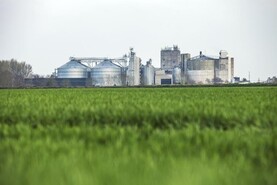Season progress: With the majority of the winter barley now harvested, many stubbles are being cleared of straw. This allows an opportunity for stubble cultivation ahead of a winter crop or a chance to plant a catch crop. If this is done under GLAS it is essential to comply with species, seeding rate and sowing date requirements. If it is being sown without aid then you have freedom on species and seeding rate.
Good progress was made in many areas over the past week, despite showers. The bulk of the winter barley is now harvested, there has been good progress on winter oats, winter rape harvesting is ongoing and combines have moved into spring barley and winter wheat.
Listen to Andy Doyle and Pat O'Toole's analysis in our podcast below:
Baling straw has been troublesome in many areas. Ground conditions are now a concern in places. Always chop straw on the headlands to help improve damaged soil.
Malting barley: The early part of the malting barley harvest has thrown up good yields plus a challenge that existed at the end of last season. Seed skinning is a quality spec and it is proving problematic again.
Recent investigation suggests that the risk of skinning (the peeling off of a portion of the seed coat) is more associated with harvesting slightly immature grain than over-mature grain. With less-mature grain the awn does not break off readily and efforts to clean the sample and break off the awn in the combine can result in pulling off a portion of the skin to which it is attached.
The risk of skinning is also associated with tighter drum/concave setting. This is even more likely in less mature crops where the drum might be set tighter to help clean a sample. So if you see skinning as you harvest, consider opening the drum slightly and reassess. Better to have a slightly dirty sample passing for malting than have a perfect sample fail. IFA is currently working with Boortmalt to check out the effectiveness of such measures.
Rape: Harvesting continues and this is not a record year for the crop. However, for those willing to lock into current prices, rape is still an attractive crop for 2017 margin-wise.
Early planting (from next week onwards) helps generate more canopy which helps prevent pigeon damage and reduces spring nitrogen requirement. The speed at which winter wheat and spring barley are maturing may put pressure on workload but early planting needs to be a priority.
Begin planting on low-fertility sites and using wide-row systems. Plant semi-dwarf and conventional varieties (and Flash) initially and then hybrids. Very high fertility sites (where high N manures are used) might best be left for another 7-10 days. Manure use is a big advantage in rape.
Plant hybrids at 35-40 seeds/m2 and conventional varieties at 65-80/m2 depending on conditions. Roll intensively if conditions are dry.
Cultivate rape stubbles post harvest to encourage volunteer germination. When you get a flush of seedlings cultivate again to promote a second flush.






 This is a subscriber-only article
This is a subscriber-only article










SHARING OPTIONS: